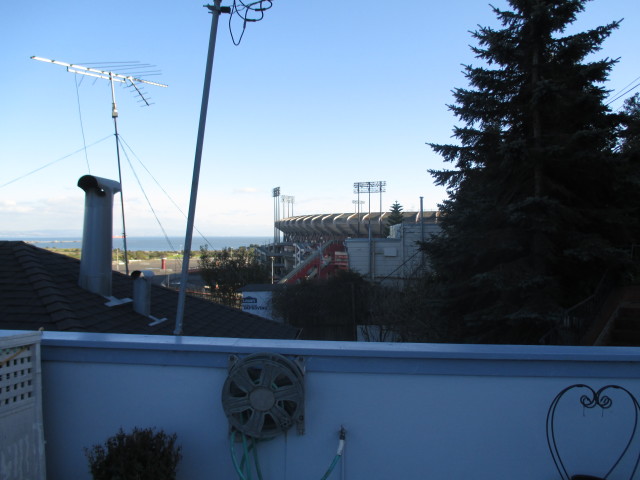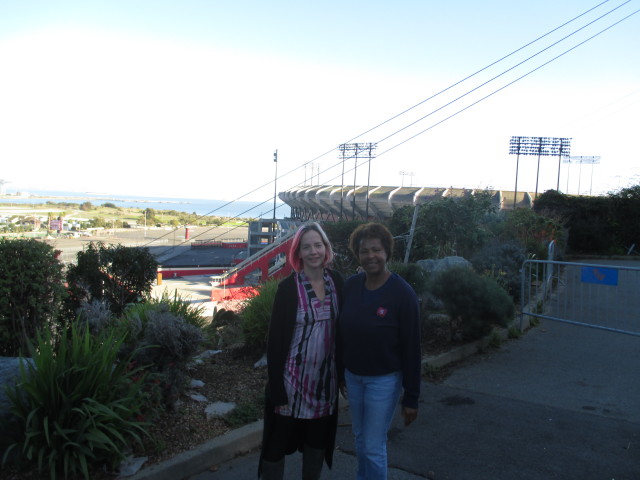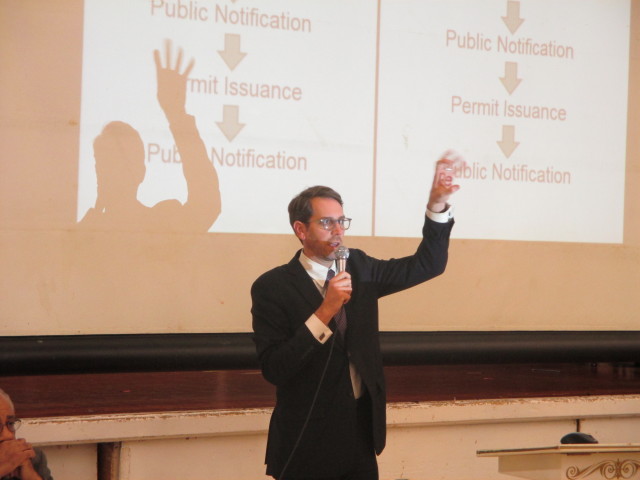
By Tim Redmond
JANUARY 7, 2015 – Stand outside of Shirley Moore’s front door and you can see Candlestick Park – easily. The empty stadium is about 300 feet away. Any decent outfielder could throw a baseball and hit the side of the structure.
If Lennar Corp has its way, someday this spring, a contractor will install several thousand explosive devices below the upper deck of the ballpark and throw the switch. The blast will cause the top sections of Candlestick to collapse in a dramatic implosion.
And Moore fears her house, her neighborhood, a nearby playground, a school, a new condo development and potentially other parts of the Bayview neighborhood could be enveloped in a cloud of concrete dust.
Lennar, which is turning the old stadium into a shopping mall, insists that all of the extensive toxic materials – for example, asbestos and lead paint – that were present in the stadium will have been removed before demolition begins.
But concrete dust alone, some studies show, is a health hazard – and critics are wondering why the developer has to blow up the ballpark instead of taking it down piece by piece, a process that could be easier to control.
“We already have the highest level of respiratory illness in the city,” she told me. “It doesn’t seem fair.”

And yet, plans to explode Candlestick are quietly moving forward, without a full environmental impact report. It could be one of the most dramatic, and potentially hazardous, projects the city has seen in years – and the response from most of the news media and political power structure is a passing shrug.
Help us save local journalism!
Every tax-deductible donation helps us grow to cover the issues that mean the most to our community. Become a 48 Hills Hero and support the only daily progressive news source in the Bay Area.
A change in plans
When Lennar first developed plans to demolish Candlestick, the process was going to be slower and more deliberate. The original EIR on the project discusses mechanical dismantling; the stadium would come down piece by piece.
That’s how most of these big demo projects happen in residential areas. The Cathedral Hill Hotel, which had to go to make way for the new CPMC hospital, was taken down in pieces – and there were workers on site with hoses soaking down the material during demolition to avoid the spread of dust.
But after the Candlestick project was approved, the developer started to change the story. “Lennar Urban is considering using (explosives) because it is difficult to demolish the upper level of the stadium using mechanical means due to the height of the structure,” an addendum to the EIR states.
Now: It’s safe to say that when Lennar decided to take on this project, and replace Candlestick with a brand-new shopping mall, and when they applied to city permission and filed all the relevant reports, the executives and demolition contractors knew how high the park stood.
Massive projects like this involve extensive cost estimates and planning. Lennar isn’t some small-time outfit doing a big project for the first time; it’s one of the biggest developers in the country, a sophisticated operation with lots of high-paid consultants and experts on the payroll. It’s hard to imagine that Lennar could have been surprised by the challenges of the mechanical demolition. And yet, that was the process discussed in all the original documents.
I asked Lennar spokesperson David Satterfield how the giant developer could have missed such a key part of the construction process. Her responded:
You raise an interesting question. The original EIR discusses the environmental impacts from conventional demolition of Candlestick and the Navy buildings at the Shipyard.
As you remember, the EIR envisioned a multitude of scenarios. It also was prepared prior to knowing the fate of the 49ers. We knew that we would be demolishing Candlestick; we did not know when. We did not know until January 2014 that the Niners officially would be vacating the stadium last year. Once that became clear, we began to explore options for demolition and our technical experts suggested the implosion method.
Let’s be real here: Implosion is a faster (but, Lennar says, more expensive) way to do it and will get the project moving forward quicker– or Lennar wouldn’t have followed that path. And I think it’s fair to say that if the original proposal had involved implosion, there would have been a lot more community opposition.
Instead, the plans changed after the fact. The city gave this a relatively brief environmental analysis and concluded:
The proposed implosion described in the Addendum will not cause any new significant impacts not identified in the Final EIR or an increase in the severity of previously identified significant effects.
Demolition derby
Let’s take a step back here and talk about what the implosion of a structure the size of Candlestick might look like. You can get a bit of a sense from what happened in 2001, when the Seattle Kingdome was blown to bits.
The videos are remarkable in two ways: The newscasters and spectators treated the event like a Fourth of July or New Year’s Eve party, with a countdown and huge crowds and all kinds of excitement.
And the massive cloud of dust that enveloped all of downtown Seattle seemed to catch everyone by surprise.
The partiers nearby were inundated with concrete dust. The newscasters a mile away were stunned when the wind shifted and the cloud came toward them. If you lived a few hundred feet from the place, your house would have been a bit dusty, and clean-up would have been rather extensive.
Candlestick was built in the early 1960s, in the days when toxins like asbestos insulation and lead paint were common in almost every big structure. There’s nasty stuff inside the ballpark; everyone knows that.
Lennar, according to the EIR addendum, has hired a mitigation contractor to remove everything that’s toxic before any demolition happens. That would be mandated even with the mechanical process.
Asbestos is a particularly bad byproduct of demolition; the tiny fibers hang in the air for long periods of time, and can travel great distances on the wind. But let’s assume for the moment that all of the bad stuff is gone when the fireworks start.
The hazards of dust
There’s still going to be a lot of concrete dust.
The dust, containing a lot of silica, isn’t good for you. Experts who advise the construction industry suggest that exposure be minimized.
The dangers of concrete dust released during demolition are also serious, and some experts suggest that extensive suppression systems ought to be used – including systems that soak down the dust to keep it from spreading.
That might work in a mechanical demolition, buy it’s not possible in a massive implosion.
In a 2005 study of the demolition of Calgary General Hospital in Canada, three experts noted that “the implosion created a dust cloud that traveled much further than expected, out to 20 kilometers.”
The particulate matter included very tiny bits – less than 2.5 microns in diameter – that can escape the body’s normal defenses and wind up embedded in the lungs.
The study, by Dennis Stefani, Dennis Wardman, and Timothy Lambert, all Canadian health officials, was published in the Journal of the Air and Waste Management Association. It concluded:
“We suggest that implosions be prohibited in densely populated areas.”
While Lennar insists that the dust cloud will be minor and won’t reach more than a few hundred feet from the stadium, there’s a level of unpredictability here.
If you’ve been around this town for a while, or you’ve followed the San Francisco Giants in the past, you know that one of the major reasons the team wanted to leave Candlestick Park is the powerful, swirling wind. That same torrent of air could carry demolition dust a long way beyond the parking lot.
The EIR addendum, which is the only document that addresses the issue of implosion hazards, notes that the demolition would be set for a time when the winds around the area are fairly calm – say, early in the morning.
Maybe that will work. But wind conditions don’t always behave the way they’re expected to — and the EIR addendum acknowledges that. In fact, the document notes that it will be hard to control dust under any circumstances: “robust winds at and around the stadium” make it “unlikely that that there are any dust palliation methods which would be effective” under any form of demolition.
And Oct. 23, 2014 letter to City Planning from the Environmental Law and Justice Clinic at Golden Gate University notes:
“If the robust winds at the stadium area render dust mitigation ineffective, how will and intense plum of [dust] that is expected to be produced by an implosion be controlled?”
Lennar says all is safe
On the evening of Jan. 5th, a crowd of several hundred gathered at St. Paul of the Shipwreck Church in Bayview to listen as Lennar executives and city officials tried to mimimize the concerns.

Bronson Johnson, the director of land development for Lennar’s Bay Area division, acknowledged that the original EIR for the project discussed only mechanical demolition. But in 2014, he said, when “we began to engage with demolition contractors, they said the stadium was an ideal candidate for implosion.”
Why? Because there weren’t many “sensitive receptors” – that is, people – nearby.
He said that under conventional demolition, excavators would crunch the concrete up bit by bit, while workers sprayed water from hoses to control the dust. That could take months.
Implosion would be much quicker, he said – over in a matter of minutes – and the dust and debris would be collected from the parking lot and disposed.
He insisted that there is no threat to public health. “We will be working as partners in this community for 25 years,” he told the crowd. “Why would we start off having a bad relationship with the residents?”
But there remains a fair deal of distrust: One person in the crowd stood up and told Johnson: “The residents aren’t going to be here in 25 years. You’re going to replace us with new people.”
When Moore asked how many in the room favored implosion, I saw no hands go up. When she asked how many favored mechanical demolition, every single hand went high.
There will be, Johnson said a “fugitive dust control plan” – which isn’t complete yet. It will have to be approved by the San Francisco Health Department.
But since the project, and the EIR, have already been approved by the City Planning Commission and the Board of Supervisors, the implosion can go forward with nothing more than a demolition permit from the Department of Building Inspection.
Raymond Tompkins, who has taught environmental chemistry at UC Berkeley, told the audience that he thinks implosion is a bad idea. “I am in favor of demolition,” he said – in fact, none of the critics of this plan want to block the Lennar project – “but I think it should be done mechanically, with water on the materials to control the dust.”
He noted than any honest environmental assessment of health risks should start with the baseline issues already facing the community. As many as 85 percent of the babies and children in the neighborhood have asthma-related conditions, he said; life expectancy for African American men in the community is only 56 years.
“You have to take that into account,” he said. “A health risk assessment has to be done.” He called the current EIR “inadequate.”
Tompkins pointed out the open secret in the room: Lennar will spend less money and less time on the demolition if it can be done with explosives. “This is an economic issue,” he said.
Other than one Examiner story, and a few short TV segments about the community meeting, most of the news reports have treated the implosion as a done deal, nothing to worry about.
When I called Sup. Malia Cohen, who represents the district, she told me she would send me a written statement, which follows:
I share the Bayview community’s concern and sensitivity regarding the environmental and health impacts of the demolition of Candlestick. I am committed to making sure that the community is educated about the process and that their voice is prioritized in the decision making process. There are a series of community meetings scheduled over the next 30 days that I encourage anyone to attend.
The Office of Community Investment and Infrastructure (“OCII”) is undertaking an analysis which will evaluate the environmental impacts of demolishing the stadium mechanically demolition and through implosion. I have hosted two community meetings about this issue thus far and rightfully, many residents have concerns over the demolition of Candlestick.
But Moore and Julia Barber, who together run the Bayview Hill Neighborhood Association’s Demolition Subcommittee, say the whole thing has happened with very little community outreach. “We were never notified,” Moore told me.
As Barber added: “It’s hard to imagine this happening in another part of town.”
There’s a petition opposing the demolition here.





